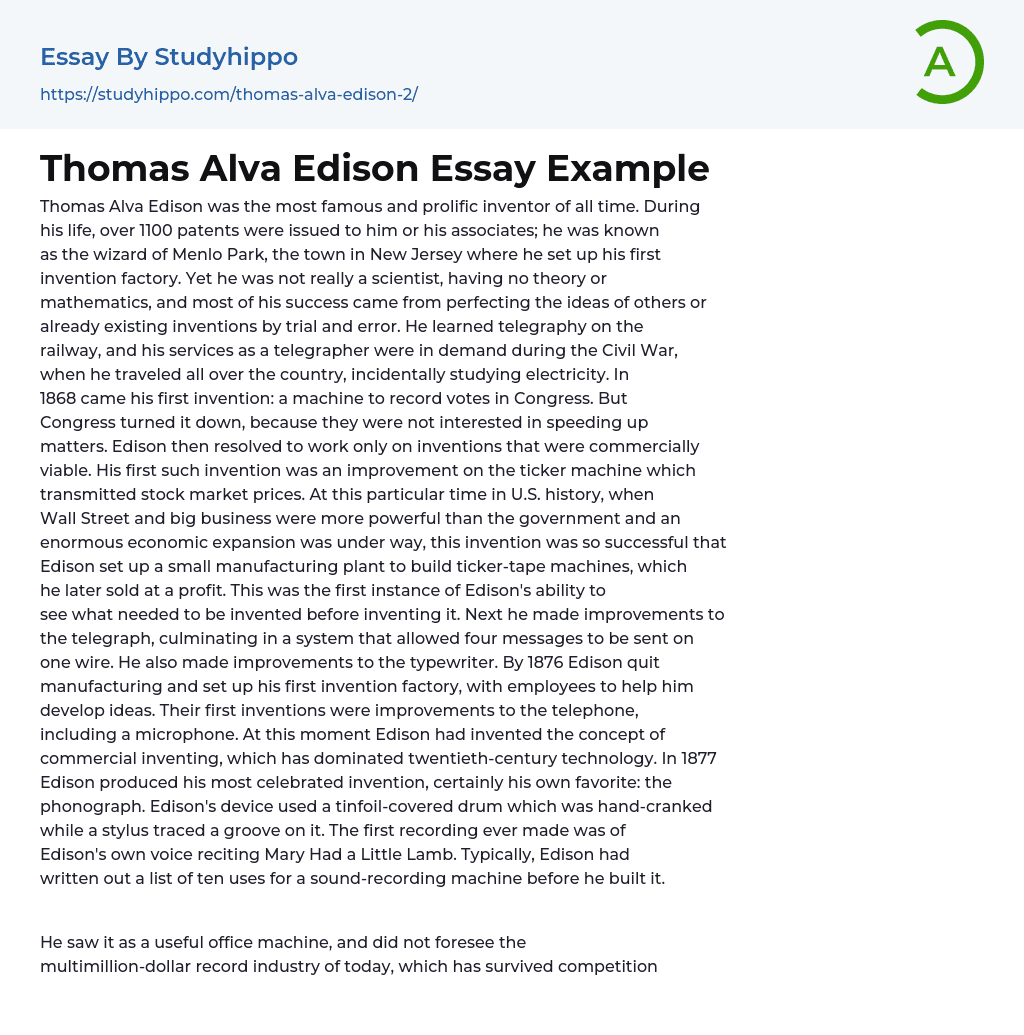Thomas Alva Edison, known as the wizard of Menlo Park, was the most famous and productive inventor of all time. During his lifetime, he and his associates were issued over 1100 patents. Despite not being a scientist or having a grasp of theory or mathematics, his success came from perfecting existing inventions or ideas through trial and error. His journey began as a telegrapher during the Civil War, where he traveled extensively, studying electricity incidentally. In 1868, he invented a machine to record votes in Congress; however, it was rejected by Congress. Undeterred, Edison decided to focus on commercially viable inventions. His first breakthrough came with an enhancement to the ticker machine used for transmitting stock market prices. During a time when Wall Street and big businesses held more power than the government, this invention proved highly successful. Edison established a small manufac
...turing plant to produce ticker-tape machines, which he later sold at a profit. This early achievement showcased Edison's ability to identify what needed to be invented before actually inventing it.Next, he made improvements to the telegraph, culminating in a system that allowed four messages to be sent on one wire. Additionally, he made improvements to the typewriter. By 1876, Edison stopped manufacturing and established his first invention factory, where he had employees assisting him in developing ideas. Their initial inventions focused on improving the telephone, which included a microphone. This marked the moment when Edison invented the concept of commercial inventing, which ultimately dominated twentieth-century technology. In 1877, Edison created his most renowned invention, and personally his favorite: the phonograph. His device consisted of a tinfoil-covered drum that was manually cranked while
stylus traced a groove on it. The very first recording ever made was of Edison's own voice reciting "Mary Had a Little Lamb." As per his usual approach, Edison had already written a list of ten potential uses for a sound-recording machine before constructing it.
Edison viewed it as a valuable office machine and did not anticipate the lucrative record industry that exists today. This industry has managed to withstand competition from radio, TV, and even Edison's own motion pictures. In 1878, Edison began researching the development of an incandescent light bulb using his trial-and-error approach. He conducted numerous experiments before finally succeeding with a charred cotton thread that could glow without being consumed when sealed in a vacuum. His team then established the principles of a generating and distributing system that made electric lights feasible for every household. The first generating plant was inaugurated in 1882 on Pearl Street in New York City.
Edison utilized a direct-current system, which was also employed by a former colleague of his, the U.S.
Nikola Tesla, a scientist of Croatian origin, invented an alternating-current system for the Westinghouse company and was ultimately successful. The Edison Electric Light Company, on the other hand, merged and grew into the General Electric Company. While working on the light bulb, Edison's only significant scientific breakthrough was the discovery of the vacuum tube. However, at that time, its properties seemed to have no practical use until the British electrical engineer John A. Fleming discovered and developed its potential for radio in 1900. In 1887, Edison relocated to a larger laboratory in West Orange, New Jersey.
In 1889, he constructed a movie camera and subsequently established a
small studio to produce brief films for peep-show machines. However, he was not particularly interested in the entertainment aspects of his invention, and instead it was left to others to advance the movie industry. On September 4, 1982, Thomas Edison used electricity to illuminate certain parts of New York. This was achieved when he turned on a switch in the offices of financier J. P. Morgan, thereby inaugurating commercial transmission of electric power from the Edison Illuminating Co., which was financed by Morgan.
The Consolidated Edison Co. started as a power plant on Pearl Street, which would soon provide electricity to all of Manhattan. This marked a significant technological advancement, eliminating the need for sunlight and candles, and doubling our productivity time. Without the invention of the lightbulb, our lives would be drastically different. Electricity is now essential even in rural areas and is relied upon daily. Edison's contributions, including the phonograph and the vacuum tube, had a lasting impact on the music industry, radio invention, and the first computer. As an inventor of such significance, Edison deserves recognition and that's why I rank him fourth on my list.
- Accounting essays
- Marketing essays
- Automation essays
- Business Cycle essays
- Business Model essays
- Business Operations essays
- Business Software essays
- Corporate Social Responsibility essays
- Infrastructure essays
- Logistics essays
- Manufacturing essays
- Multinational Corporation essays
- Richard Branson essays
- Small Business essays
- Cooperative essays
- Family Business essays
- Human Resource Management essays
- Sales essays
- Market essays
- Online Shopping essays
- Selling essays
- Strategy essays
- Management essays
- Franchising essays
- Quality Assurance essays
- Business Intelligence essays
- Corporation essays
- Stock essays
- Shopping Mall essays
- Harvard Business School essays
- Harvard university essays
- Trade Union essays
- Cooperation essays
- News Media essays
- Waste essays
- Andrew Carnegie essays
- Inventory essays
- Customer Relationship Management essays
- Structure essays
- Starting a Business essays
- Accounts Receivable essays
- Auditor's Report essays
- Balance Sheet essays
- Costs essays
- Financial Audit essays
- International Financial Reporting Standards essays
- Tax essays
- Accountability essays
- Cash essays
- Principal essays




